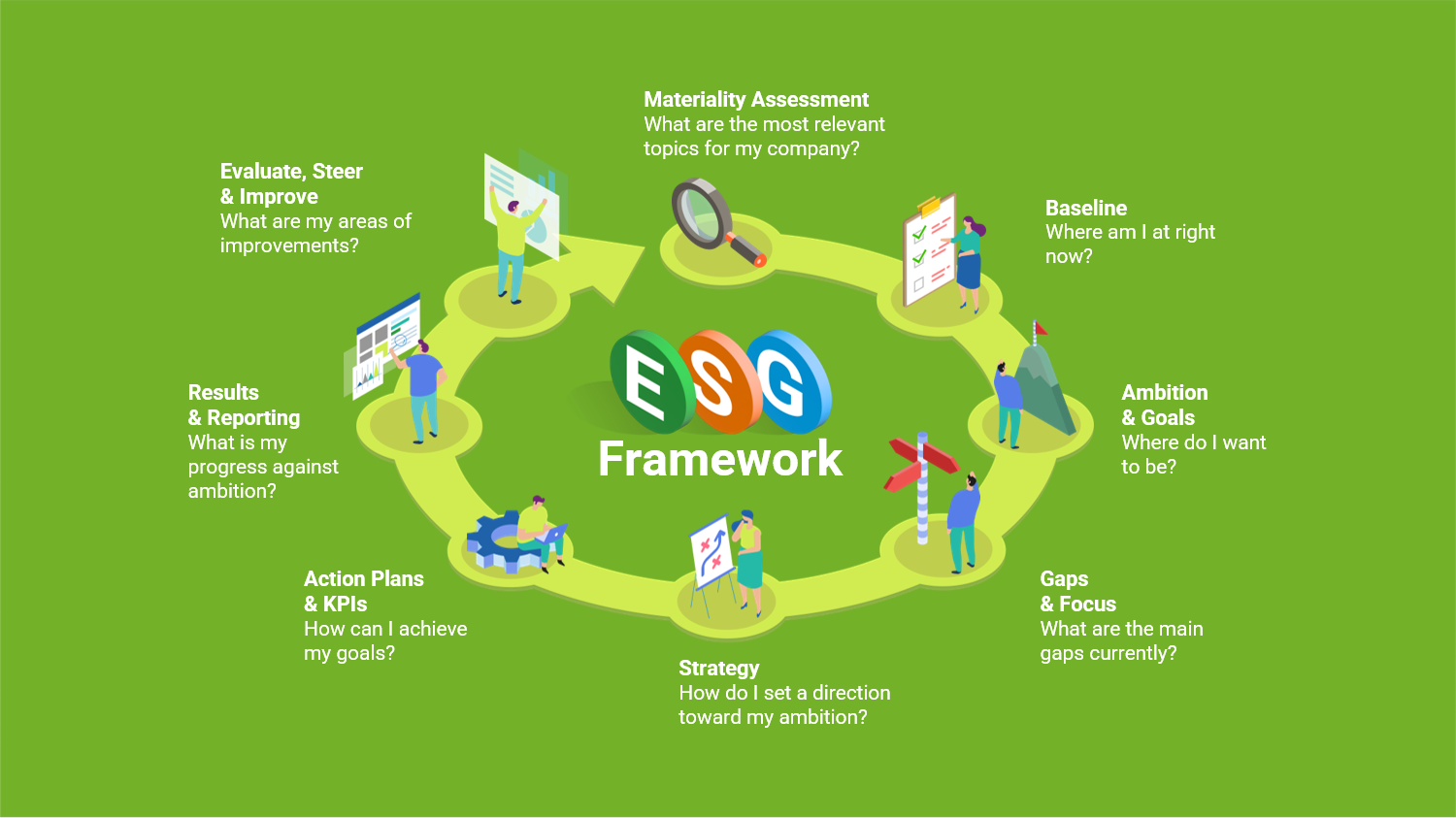ESG Phase 4: reporting, evaluating and fine-tuning
More and more these days, society is demanding companies to take responsibility for sustainability, corporate social responsibility and transparent governance. This means that sustainability (or ESG) has to be high on an organisation’s list of priorities. All the more so because many companies have or are soon to have a mandatory reporting obligation. How are you going to ensure that you comply with all the mandatory ESG reports, like those required by the CSRD? Baker Tilly can help you with this by setting up an ESG framework for you. We work towards having an integrated strategy based on four phases. During Phase 4 of the framework, you will start working on your sustainability reporting.
ESG framework
Reporting, evaluating and making adjustments together constitute Phase 4 of the ESG framework developed by Baker Tilly . In total there are four phases, divided into eight steps. Based on these phases, we work towards an integrated strategy and your sustainability report, one step at a time.
Accountability through reporting
In this final phase, you will start working on your sustainability report. From 2025 onwards, companies meeting two of the following criteria will be required to report on the impact that their operations have on climate, biodiversity and human rights:
250 members of staff
40 million euro in turnover
a balance sheet total of 20 million euros or more
This reporting obligation makes your directors’ report even more important than it already was. Your sustainability report becomes your means of accounting for your contribution to the Paris Climate Agreement.
Why a sustainability report?
It is an important tool that organisations can use to inform their stakeholders of their environmental, social and governance (ESG) achievements. From 2025 onwards, providing information on your organisation’s sustainability practices, impacts and initiatives, in a standardised and structured way, will be mandatory.
The advantages of a sustainability report
Transparency and accountability
A sustainability report provides a clear picture of your organisation’s performance in terms of ESG. This information can be used to hold organisations accountable for their impact, and to drive improvements in their sustainability performance.
Risk management
The process you go through to compile a report helps your organisation to identify and manage ESG risks and opportunities. Reporting is one of the final steps in your ESG strategy. In the process, it helps you to identify areas for improvement and take action to mitigate risks.
Reputation and brand image
Sustainability reporting can enhance an organisation’s reputation and brand image by demonstrating its commitment to sustainability and transparency. This can help attract clients, investors and employees, since these stakeholders are increasingly interested in sustainability issues.
Compliance with regulations
Many countries and jurisdictions have mandatory reporting requirements for ESG. By going through this phase carefully, you will meet these requirements. Sound sustainability reporting also helps you to avoid legal and regulatory risks.
Stakeholder engagement
A sustainability report gives you a platform on which to engage with your stakeholders on sustainability issues. For example, you can engage with suppliers on how to make improvements, and it encourages you to be more attentive to your clients’ needs.
Getting started on your sustainability report
Sustainability reporting is a complex and detailed process that requires careful planning and execution. To compile a comprehensive sustainability report, you will need to complete the following steps:
Define your scope
Define the scope of your sustainability report by identifying the relevant ESG issues for your organisation, stakeholders and the reporting standards.Gather information
Gather information on your organisation’s performance, including information on energy consumption, greenhouse gas emissions, waste management, water consumption, social impact and governance practices. It is important to ensure that the information you collect is accurate, reliable and consistent.Set goals and targets
Set sustainability targets that align with your organisation’s strategic objectives and applicable reporting standards. These goals and targets must be specific, measurable and time-bound.Compile your report
Compile the information you have collected into a clear and concise report that tells the story of your organisation’s sustainability performance. The report must be properly structured, transparent and comprehensible for your stakeholders.Get feedback
Ask for feedback about your sustainability report from internal and external stakeholders, including your staff, investors, clients and suppliers. They will look at your report from a different perspective and can point out any blind spots you may have.Communicate about your report
Tell your stakeholders about your sustainability report via various channels, like your website, social media and the annual report. It is important to ensure that all your stakeholders have access to your report and that you provide them opportunities to give feedback and engage in dialogue.
Evaluation and fine-tuning
There’s a good reason for reporting: it’s the perfect opportunity for evaluation and fine-tuning when necessary. We call this the ‘check and act phase’. During this phase, you not only check whether the report is correct and complete, but also whether you have the right information. This enables you to take the proper actions to adjust your strategy.
Check: monitor and evaluate the results of your strategy. Gather information and measure performance against the goals and objectives you have set. Analyse the information, identify any trends or patterns and compare the results with the ones you expected.
Act: if the results meet your expectations, standardise the new process, document it and communicate it to all stakeholders. If the results fail to meet your expectations, review and revise the plan, adjust the process and implement the new plan.






